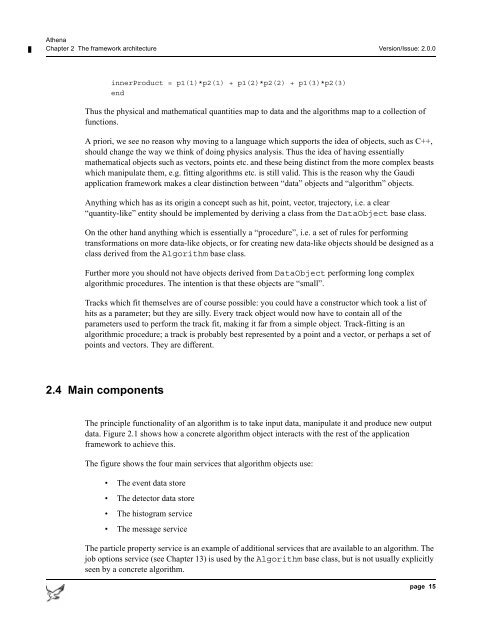Athena Developer Guide
Athena Developer Guide
Athena Developer Guide
Create successful ePaper yourself
Turn your PDF publications into a flip-book with our unique Google optimized e-Paper software.
<strong>Athena</strong><br />
Chapter 2 The framework architecture Version/Issue: 2.0.0<br />
innerProduct = p1(1)*p2(1) + p1(2)*p2(2) + p1(3)*p2(3)<br />
end<br />
Thus the physical and mathematical quantities map to data and the algorithms map to a collection of<br />
functions.<br />
A priori, we see no reason why moving to a language which supports the idea of objects, such as C++,<br />
should change the way we think of doing physics analysis. Thus the idea of having essentially<br />
mathematical objects such as vectors, points etc. and these being distinct from the more complex beasts<br />
which manipulate them, e.g. fitting algorithms etc. is still valid. This is the reason why the Gaudi<br />
application framework makes a clear distinction between “data” objects and “algorithm” objects.<br />
Anything which has as its origin a concept such as hit, point, vector, trajectory, i.e. a clear<br />
“quantity-like” entity should be implemented by deriving a class from the DataObject base class.<br />
On the other hand anything which is essentially a “procedure”, i.e. a set of rules for performing<br />
transformations on more data-like objects, or for creating new data-like objects should be designed as a<br />
class derived from the Algorithm base class.<br />
Further more you should not have objects derived from DataObject performing long complex<br />
algorithmic procedures. The intention is that these objects are “small”.<br />
Tracks which fit themselves are of course possible: you could have a constructor which took a list of<br />
hits as a parameter; but they are silly. Every track object would now have to contain all of the<br />
parameters used to perform the track fit, making it far from a simple object. Track-fitting is an<br />
algorithmic procedure; a track is probably best represented by a point and a vector, or perhaps a set of<br />
points and vectors. They are different.<br />
2.4 Main components<br />
The principle functionality of an algorithm is to take input data, manipulate it and produce new output<br />
data. Figure 2.1 shows how a concrete algorithm object interacts with the rest of the application<br />
framework to achieve this.<br />
The figure shows the four main services that algorithm objects use:<br />
• The event data store<br />
• The detector data store<br />
• The histogram service<br />
• The message service<br />
The particle property service is an example of additional services that are available to an algorithm. The<br />
job options service (see Chapter 13) is used by the Algorithm base class, but is not usually explicitly<br />
seen by a concrete algorithm.<br />
page 15
















